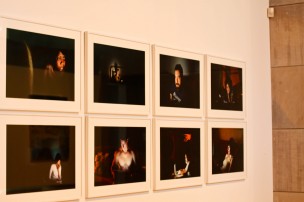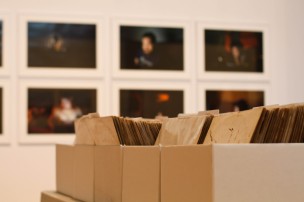The Ezra and Cecile Zilkha Gallery houses a new exhibition, organized in honor of the 40th anniversary of the Center for the Arts. The exhibition features works of art by alumni artists that include paintings, sculptures, installations, photography, video art, performances, films, and even jewelry. Building on the previous alumni show in 2003 and curated by John Ravenal ’81, P’15, The Alumni Show II exhibition presents an entirely new and vibrant selection of artists.
After a morning of classes, tired and drowsy, I stopped by the gallery and ended up spending an inspiring afternoon
viewing, interpreting, and understanding the various works of art.
I was drawn by eight portrait photographs immediately to my right, each with a figure looking extremely attentively into a computer screen, the only source of light set against a dark background. Though each figure has a different facial expression, all of them are absorbed in their private and virtual connections to an unseen world, reclusive from the common dark background, the physical everyday life. Through the mysterious and even ghastly atmosphere, photographer Gabriela Herman ’03 seems to warn the viewers of a problem in our lifestyles during this tech-filled era. Indeed, as the description reads, she successfully examines the connectivity in the digital age and the ways in which we live and spend our time.
The most special piece in this exhibition may be John Hatleberg ’79’s “Hope Diamond.” I’m usually exposed to so many idiosyncratic and high-tech mediums of contemporary art, and it felt so fresh to see this traditional material of beauty. The blue, dazzling stone sits serenely and elegantly on a pedestal on the inside of the gallery space, nobly waiting for viewers to encounter it with both surprise and respect. Hatleberg’s goal is to find beauty itself. Compared with many contemporary pieces of art, which carry complex and abstract meaning, this piece seems to recall the origin of art: The enthusiasm of human beings in pursuing aesthetic experiences.
The variety of subject matters and media that the alumni artists work with reminded me of the importance of the liberal educations they all received while at Wesleyan. Herman noted that the University fueled her passion for connecting with different cultures and capturing a sense of people’s lives. Arturo Vidich ’03, whose video of dance is on display, explained that his experiences with student-led initiatives at the University trained him to be able to deal with the real world.
What Ian Boyden ’95 learned at the University stimulated the brilliant idea of presenting the stories behind natural phenomena, such as volcanism and sublimation across fields and seas and mountains, in his series work, “Eccentric Orbit.” Using minerals and natural material to bring the work to life, Boyden transports the viewer to the very places where those processes take place. While other painters care more about colors and paint, Boyden presents a unique perspective as he focuses on the origin of those materials.
Appreciating the quintessence of the Wesleyan experience through the medium of art proves a fresh way to kick off the new semester. The show runs through Dec. 8, and exploring the University’s vibrant arts culture through this “kaleidoscopic” show, as Ravenal notes, is sure to encourage students to embrace all of the opportunities that the University has to offer.

